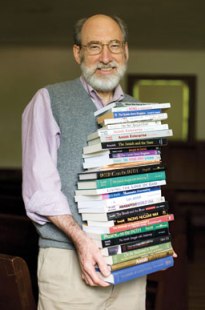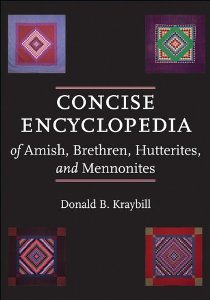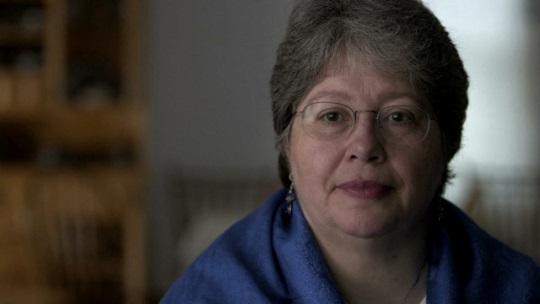Concise Encyclopedia of Amish, Brethren, Hutterites and Mennonites: 5-book giveaway and interview with Donald Kraybill
Donald Kraybill just had a busy month.
Most people would consider releasing one book an event, but in October Kraybill released two–The Amish Way: Patient Faith in a Perilous World, co-authored with Steven Nolt and David Weaver-Zercher, and the Concise Encyclopedia of Amish, Brethren, Hutterites, and Mennonites.

Timing of the release was something of a coincidence; while The Amish Way was a more recent project, the Concise Encyclopedia had been in the works for a decade.
Today, Kraybill shares about the Concise Encyclopedia and the many diverse Anabaptist groups in North America.
Browsing through the Concise Encyclopedia, I’ve learned that there are Brethren in Cuba, how Amish quilts came to be considered art, and more about the people known as Bruderhof, a group once connected with the Hutterites.
Concise Encyclopedia 5-book giveaway: How to Win a Copy
Johns Hopkins has kindly shared 5 copies of the Concise Encyclopedia for a giveaway contest for Amish America readers. There are a few ways to enter this contest:
1) leave a comment on this post. That gets you 1 entry!
2) mention this contest on Facebook and/or your blog.
A Facebook mention gets you an extra 2 entries, and a blog mention gets you 3 (be sure to let me know you did either or both of these, by sending a quick email to amishamerica@gmail.com).
So that makes a total of 6 possible entries (1 for a comment+2 for Facebook+3 for blog).
The 5 winners will be drawn and shared on this blog in one week–on next Monday, November 22nd.
Interview with Donald Kraybill on the Concise Encyclopedia of Amish, Brethren, Hutterites, and Mennonites
Amish America: Why did you compile such a book?
Donald Kraybill: I felt there was a need for a single book that would provide an overall short and concise introduction to all the Anabaptist groups in North America. Many people don’t realize how many different groups there are, how diverse they are and where they are located. So my purpose was to provide a single one-stop source for journalists, students, scholars, and others interested in learning about the Anabaptist North America.
How did you decide which groups to include?
Kraybill: Well there are four major Anabaptist tribes: Amish, Brethren, Hutterites, and Mennonites. So that was a pretty easy choice. However inside those tribes there are many subgroups and the decision of who to include or exclude sometimes was difficult. In general I used four criteria: if the group used a tribal name, i.e. Amish in the name of their group; if in their literature the group described itself as “Anabaptist”; if the group was listed in a directory of Anabaptist Churches; and if the group identified itself with a network or fellowship of Anabaptist related churches.
Why did you write all the entries yourself?
Kraybill: It’s true that the essays in many encyclopedias have contributions by individual specialists. This volume is a bit unique because it tries to be very concise. I tried to write short overview essays. By writing them myself I could keep the style, content, and tone more uniform. In some ways doing it this way complicated the process because I had to master so much information. On the other hand, it made it easier because I didn’t have to work with dozens of other people!
How many groups are covered in the book?
Kraybill: Actually a total of 205. We created a directory of groups at the back of the book which lists all of them and their location by affiliation and country in North America.
And how many Anabaptists are there in North America?
Kraybill: Well, we identified 8,711 congregations and 809,845 baptized adult members. It was impossible to make reasonable estimates of population (adults and children) because most of the groups report the number of baptized members not total population. If I were to guess I would estimate that the total population of Anabaptist groups in North America is 1.4 million.
Which of the four major groups is the largest, and which is the smallest?
Kraybill: Counting adult members only, the Mennonites constitute 63% of the Anabaptist world. The Hutterites are the smallest with about 2.4%. The Amish community are 12.8% of the North American Anabaptist world.
What are the boundaries of North America?
Kraybill: Well that’s an interesting question because when I began I naïvely assumed that North America meant the United States and Canada. I soon discovered that North America also includes the Caribbean territories and countries, Central America, and Mexico. It’s actually a total of 23 countries! Not just two like I thought originally. Anabaptist groups are found in 17 of the 23 countries.
How many of these countries have Amish churches?
Kraybill: The Amish are only found in United States and Canada. To be exact in 28 states and in Ontario.
In many of the essays you make a distinction between traditional and assimilated Anabaptist groups. What does that mean?
Kraybill: Well, members of some groups are very traditional, such as the Old Colony Mennonites and Old Order Amish. But other groups are very change minded and very active in mainstream society, whether it’s Mexico or Canada or the United States. Members of these churches engage in political affairs, attend public universities and are involved in professions and use high technology. So I was searching for a way to make a distinction between these two broad categories. It is better to think of a spectrum or a continuum from a tradition-oriented way of life to a change/progressive mindset.
So what are the key aspects of that continuum?
Kraybill: The two key components are these: how separated the group tries to be from the larger culture and whether moral authority is invested in the group or given to the individual. In short: it’s about separatism and individualism. I see dress as the key indicator of where a group stands on the continuum. Churches which require a prescribed dress for their members are toward the traditional whole because dress signals a more separatist boundary with the larger culture, and secondly individuals are willing to give up their right to dress as they please and to follow the moral guidelines of the church.
You mentioned Old Colony Mennonites. Where do they live and how are they different from the Old Order Amish?
Kraybill: Well, read the Encyclopedia! No, actually the Old Colony Mennonites have a Dutch Russian ethnic background. They migrated from Russia to Canada in the late 19th century and then in the early 20th century from Canada to Mexico. In recent years some of them have moved back to Canada and to some areas of the United States. Historically they have been extremely traditional, even more so than the old order Amish.
Today some of the Old Colony Mennonites are still very tradition-oriented but others are in various stages of assimilation into the larger culture. The Amish by contrast come from South German Swiss background. One of the interesting things is that some Amish groups in the United States have sent school teachers to Mexico to train and work with teachers and help upgrade the quality of education in Old Colony Mennonite schools.
How did you decide which topics to include?
Kraybill: Well that was actually quite difficult. I decided to focus pretty much on cultural topics in the 20th century but those of course overlap with historical and religious ones. Thus the Concise Encyclopedia has more of a socio-cultural feel rather than a historical one. I decided to only write an essay on people who were a founder of a particular church in its first 50 years. Otherwise, although I mentioned people in the various essays, there are not essays on any contemporary people. I also tried to think of topics which people outside Anabaptist circles—journalists, scholars, students and so on might want information on.
What are examples of some of the essays?
Kraybill: If we take an ABC approach the list would include some of these: abortion, agriculture, alcohol, Asian-American Anabaptists, automobile, baptism, beard, Central America, cinema, cookbooks, dancing, and yes the holy kiss!
Which essays did you find most interesting and/or surprising?
Kraybill: I must confess the biggest surprise I discovered was that there are Mennonites in the Bahamas! They are purportedly doing mission work, but I haven’t done any field work there to determine the accuracy of their claims! I think another surprise for me was the entry on dialects. We discovered that there are some 256,000 Pennsylvania German dialect speakers in North America. This includes adults and children but it adds up to a quarter million people speaking this unique dialect at their breakfast tables every morning.
Donald Kraybill is Senior Fellow at the Young Center for Anabaptist and Pietist Studies at Elizabethtown College.







thank you, Erik, for offering one more opportunity to win a good book. sign me up. : )
Another great giveaway!!
This sounds like a great book to have. Please enter me in the contest!
This looks like a very interesting book. I always enjoy Dr. Kraybill’s insight. Thanks for hosting the contest.
Wow, is about all I can say.
I would love to win a copy of this book,
Thank you so much for your continued information and photos on this interesting culture. I look forward to reading it every day. And thank you for the wonderful interview with Donald Kraybill. I would appreciate being placed in the drawing for the contest.
I’d love to have a copy of the Encyclopedia! Count me into the contest!
Count me in! Thanks!
Awesome news! I would love to be entered as well. Thanks for the chance!
I would love to win one of these. Thanks for having the giveaway.
I have several of his books already, and welcome the chance to win one. sign me up!
I would LOVE to win this book! Thanks for the chance! 🙂
Another great interview. Love this website. Please enter me in the contest. Thank you.
Amazing! Dr. Kraybill is definitely the authority on all things Amish!
Please enter me in the contest. Thank you.
Sounds fascinating! Sign me up.
I am Amish. I like free things. Enter me. Bye.
P.S. What a smart way to get lots of comments on your blog!
I look forward to reading this book. Please enter me in the giveaway. Thanks
Enter me in the contest. Don does an excellent job with writing about this subject. Can’t wait to read it. Eric, you do a great job with Amish America.
Please enter my name into your contest for the book giveaway. Thank you.
So excited to read this one! I’m such a fan of Donald Kraybill.
count me in
I’d love to have a book.
I would love to win this.
I would very much like to win this book.
I love the sociological aspect of this book as opposed to just the historical approach. I’ve read alot about the history but am always looking for more about the culture of anabaptists. Looking forward to referencing this new book.
I have all of Dr. Kraybill’s books and will definitely add this to the collection.
I had the pleasure of meeting Dr. Kraybill at one of his book signings. Can’t wait to check it out.
Thanks everyone for all the great comments so far!
I appreciate the interview with Donald Kraybill and the opportunity to win a copy of the encyclopedia. This book is an amazing undertaking.
Please throw my name into the hat!
count me in to win
Please enter me in the drawing. Thanks!
Erik,
Thank you for the contest opportunity! I really enjoy your blog and all the interesting information you put up for us. It is on some days, the simplest moment I find. 🙂
Count me in, please.
Thanks-
Michelle V
I’ve been interested in the Anabaptists for a while now, and this book sounds like the best way to read up on all of them! Please enter me in the giveaway!
I’d love to have a copy of Dr. Kraybill’s new book. So much to learn, yet. Thanks for this post – it’s one of favorites ever.
Just a few quick responses, which I wish I could for everyone but at least here’s a go (in reverse order):
Sherry Gore-thanks are definitely due to Don here! I always enjoy his contributions and I consider myself fortunate to know him–not just for all that I’ve been able to learn but because when you get to know him you find he is such a warm and selfless person.
tania smith-“It is on some days, the simplest moment I find.” Boy that is too kind! If I ever need testimonials about this blog I am going to come to you tania 🙂 thanks x100
Elizabeth-yes I appreciate the sociological side too. Very well done here as in others by DBK.
Leanna-another comment that made my day, very kind of you.
Gideon Yutzy-I do love comments, so thanks for pitching one in the pot…By the way I had a look at your site and enjoyed seeing you are in Poland, too. That is where I spend a nice spell of my year, anyway.
Here’s a few more responses:
Doris Blankenship Wellman–Doris, and I look forward to having a chance to share a little bit with you. Many kind thanks to you.
Katie Troyer–well wow, back atcha then!
Mark Fitzgerald–teaching such a diverse class may take a little sorting. Well better late than never I guess 🙂
richard-that is okay, I certainly appreciate your and everyone else’s “non-contest” comments too. These are fun because I get to hear from folks that I might not normally 🙂
Monica-I think a new name could be in order here, maybe “Bahamonites”? Alright enough with the comedy already 🙂
Dan Greenfield–glad you are liking Amish Way and thanks for sharing the contest on your blog.
Carol Wong–doing contest entries in future on Twitter, you ask? interesting idea! you know I am on twitter, but don’t ‘twit’ too much myself–I have to admit I still don’t ‘get’ twitter as much as maybe I oughtta. But I will put the idea in the hat. In fact, the next contest is actually going to have a totally different way to enter than any we’ve seen so far (for a little variety here, I hope!)
Holly Graves–glad you get my emails, as long as the “automatic post email machine” keeps sending them I am happy 😉
Linda Harvey Kelley–I think you are fortunate to have had such friends for so long. Thank you for sharing.
Robin Grossbier–there are a few nice sections on Hutterites in the Concise Encyclopedia which I found quite helpful, so I think you’ll enjoy that bit.
what a delight it would be to win a copy of your book. Thanks for allowing me to enter. God Bless.
THank you for the oppurtunity -please, please let me win, I love your site and newsletters. I live in South Africa and I am a missionary, If I cannot win a book, I would love to pay a visit to the mennonites, or amish I SHALL BE PRAYING THIS SIDE. GOD BLESS
PLEASE LET ME WIN, GOD BLESS AND I AM PRAYING THIS SIDE LOVE IN CHRIST JESUS THE SAVIOUR
Count Me In
A rest area attendant on I-88 squinted at me and asked: “what are you?” I squinted back, stunned and mute for a change! I sometimes get mistaken for Amish, even by Amish themselves until they take a close look. Or Mennonite? A Hasidic Jew, perhaps? German Baptist is closer, but Conservative Quaker is right on the money. Without portfolio, at this point, I’m afraid.
In any case, I would like to enter the contest.
Non contest comment :)
I do look forward to reading, and perhaps one day owning the Kindle edition of this encyclopedia. I confess to slowly becoming hooked on Kindle ~ those books are always handy and take up virtually no space in my tiny home. 😉